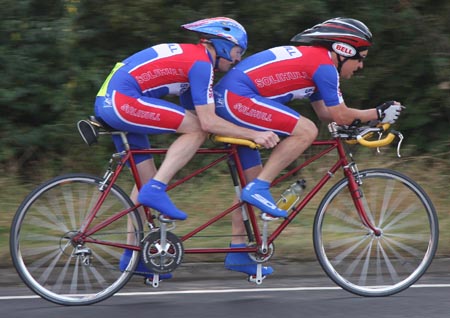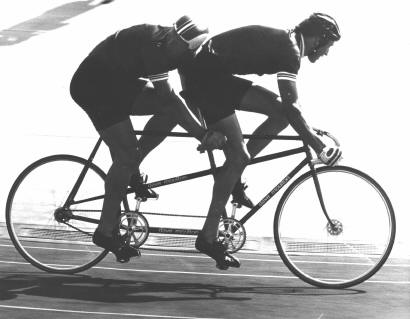1975 Tandem
 Wed, March 16, 2011
Wed, March 16, 2011 
Colin Williamson who lives in the West Midlands area of the UK, sent me pictures of a tandem frame I built in 1975.
He bought the tandem from the original owner about 15 years ago and used it for light touring with his wife. Then three years ago he stripped the frame and had it repainted. He then rebuilt it as a racing tandem.
Together with his stoker Dave, (He didn’t give a second name.) Colin won a couple of tandem time trials last season.
I still have my frame number register book for frames built in England; this one happens to be the first tandem frame I built. Nice to know that 36 years later it is still being put to good use.
The frame size is 23 inches (58 cm.) front, and 21 inch (53 cm.) rear. From the picture above, it appears that the frame fits Colin and Dave as if it were built for them. There is no wasted space between the two riders, and Dave’s knees barely clear the rear handlebars.
The two riders are members of the Solihull Cycling Club, and compete in the “Veterans” class, with a combined age of 115 years. The pair have recorded a 21 minute 10 mile event, and a 53 minute 25 mile time trial.
I did a quick count, and it appears that I built 25 tandem frames in the UK from 1975 to 1978; I also built maybe 2 or 3 while I was at Paris Sport from 1979 to 1980.

Another tandem I built in 1978, (Picture above.) was ridden by Paul Swinnerton, (Front.) and Trevor Gadd (Stoker.) in the World Championships that year. The event was the tandem sprint event.
To witness these two powerful young athletes muscle this machine around a banked track at speeds approaching 55mph, was both inspiring, but at the same time, a little frightening for me knowing that I had built it.























Reader Comments (7)
Awesome stuff, Dave. Is that normal to have the riders so close together? Not very pleasant for the guy in the back, methinks. But 21 minutes for 10 miles, that's insanely fast.
Must be rewarding as hell to see your craftmanship out on the road 35 year later. Chapeau.
Mikey,
Close is good, especially for Time-Trialing. Less turbulance and wind resistance. Plus the smaller/shorter frame equals more stiffness.
Dave
Too cool! I noticed the diagonal tube is placed differently on the track frame. Any reason for the change in location?
Zed,
The road tandem at the top has two sets of twin tubes (1/2 inch dia.) running diagonally on either side of the main frame tubes, rather like a mixte frame. This is far simpler than the single large tube that runs through the center of the track tandem, with extra twin stays finishing just above the rear dropouts.
Any frame will tend to twist about an axis running through the center of the frame from the head tube to the rear drop out. This is because the rider (Riders on a tandem.) pull up on the handlebars as they push down in the opposite direction on the pedals, effectively twisting the frame, first one way then the other.
Placing a large tube along this axis means in order for the frame to twist, this center tube also has to twist. A tube has a strong resistance to twisting, so this design makes the stiffest frame possible needed for track sprinting.
Dave
Interesting post - didn't realize you built tandems as well.
hi Dave!
on these tandems the head tube angle is similar with a "normal" bike or a bit steeper? what about trail; smaller, bigger?
regards,
Mircea
Hi Dave,
I live in UK and I have acquired a tandem frame bearing the name of your mentor A & J Hodge of Luton, I don't know the exact age of the frame ( it's numbered 1407) but I believe it to be pre-1950. It's very short wheelbase at 60" with a curved seat tube but looks to be made to accept mudguards so very likely a 'road and path' model. When I bought the frame it was equiped with block drive chain and roller timing chain and Williams in line drive but no wheels. The pilots handlebars (42cm) which are mounted on a long reach (10.5cm) stem are considerably narrower than the stokers (45cm) bars which are mounted on a combined horizontal seatpost and 'Major Taylor' stem. The frame I think was made with Chater-Lea lugs and may have had C-L drive originally.
I intend to restore the bike and would be grateful for any useful information you might be able to provide, I can supply any measurements from the frame and would like to find out what size riders the bike is likely to have been made for and also what size wheels it was designed for. Also any information on the makers approach to tandem design and build would be interesting.
You can see what I bought at eBay item No.111166037301.
Regards, Phil.